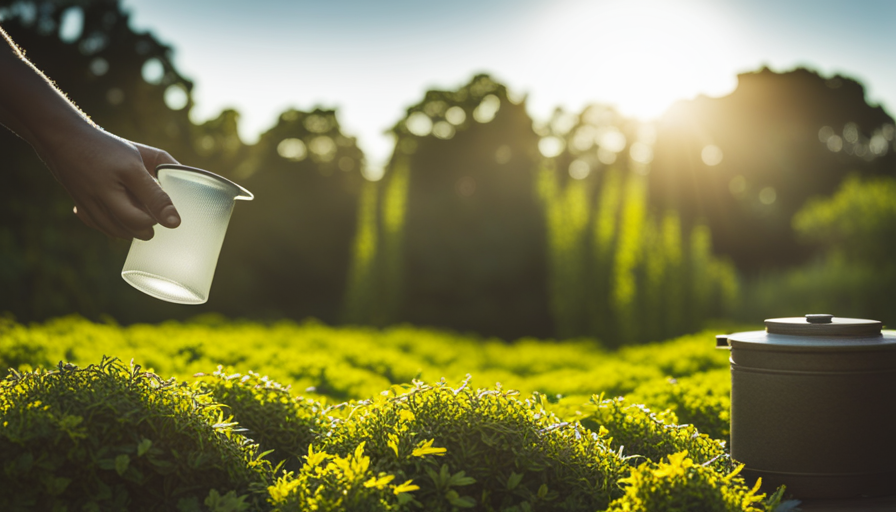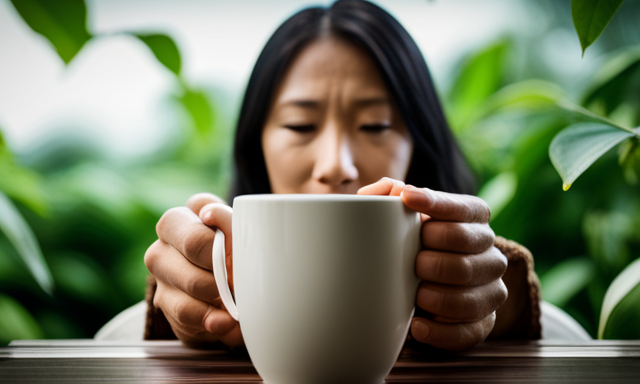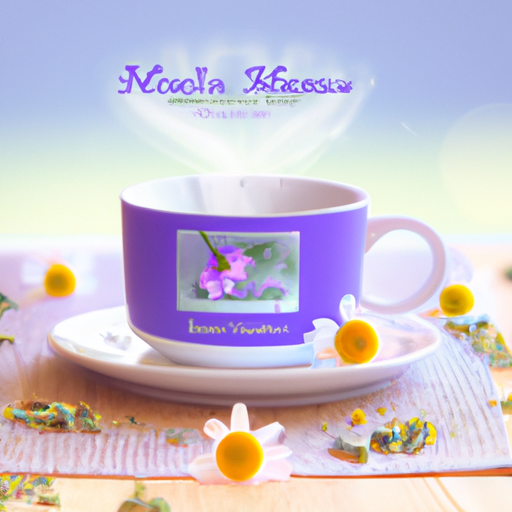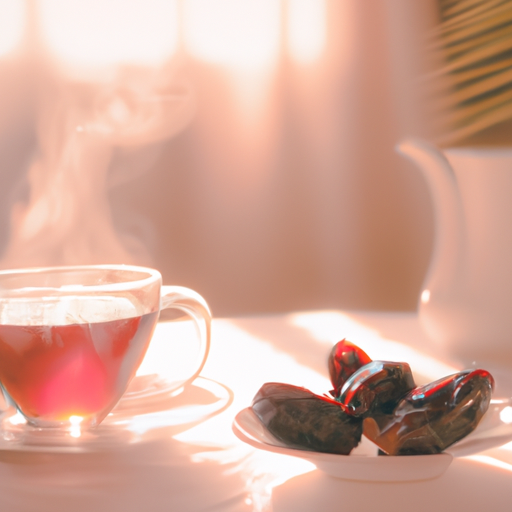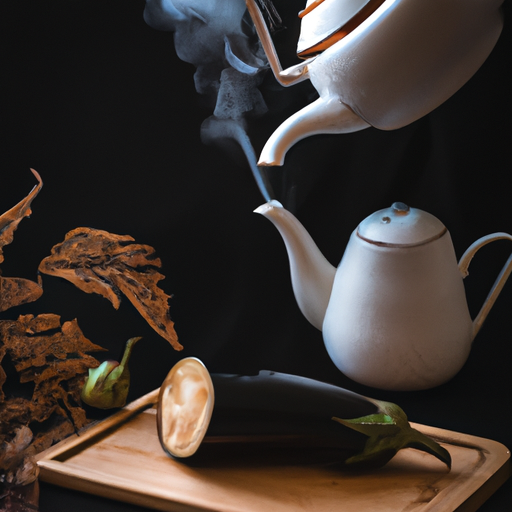Are you looking to break free from boring tea flavors? Are you ready to explore a world of delicious tastes and health benefits? Then get ready to awaken your senses and calm your soul by creating your own herbal tea.
Like a symphony of flavors dancing on your taste buds, creating your own herbal tea is a journey of self-discovery and nourishment. It’s like being a master alchemist, blending together nature’s finest ingredients to craft a warm and comforting brew.
In this article, I will guide you through the steps of creating your own herbal tea, from selecting the perfect herbs to steeping the tea to perfection. So, grab your tea kettle and let’s dive into the magical world of herbal tea making.
Get ready to sip, savor, and experience the blissful harmony of flavors that only your own homemade herbal tea can provide.
Key Takeaways
- Different herbs have different health benefits and properties, so choose herbs like chamomile and lavender for relaxation, echinacea and elderberry for boosting the immune system, and peppermint and ginger for digestion.
- Steep delicate herbs like chamomile and lavender at 175°F (80°C), and hardier herbs like peppermint and ginger at 212°F (100°C), to extract optimal flavor and benefits.
- Use around 1-2 teaspoons of herb per cup of water for a balanced infusion, and experiment with different herb combinations to find your favorite flavors and benefits.
- Enhance the taste of herbal tea by adding sweeteners or flavorings like honey, lemon, cinnamon, or vanilla extract, and carefully remove the infuser or strainer from the mug after steeping.
Choose Your Herbal Ingredients
Now that you’ve gathered all the necessary equipment, it’s time to dive into the fun part – selecting your favorite herbs and spices to create a truly personalized herbal tea blend.
Herbal tea has been enjoyed for centuries for its numerous health benefits and soothing properties. Whether you’re looking to relax, boost your immune system, or aid digestion, there’s a herbal tea recipe out there for you.
When choosing your herbal ingredients, it’s important to consider the specific benefits and flavors they offer. For relaxation, chamomile and lavender are perfect choices, known for their calming properties. If you’re looking to boost your immune system, echinacea and elderberry are excellent options. For digestion, peppermint and ginger are go-to herbs. You can also get creative and experiment with different combinations to find the perfect blend that suits your taste and preferences.
To gather your supplies, head to your local health food store or herb shop. Look for organic, high-quality herbs and spices to ensure the best flavor and potency. You can also consider growing your own herbs in a small garden or even in pots indoors for a more sustainable and cost-effective option.
Once you have your herbs, it’s time to start brewing your own delicious and beneficial herbal tea concoctions.
Gather Your Supplies
First, grab all the necessary tools and ingredients for brewing your own delicious blend of therapeutic plants. To make your own herbal tea, you’ll need the following:
-
Fresh or dried herbs: Choosing the right herbal ingredients is crucial for creating a tea that suits your needs. Consider herbs like chamomile for relaxation, peppermint for digestion, or lavender for stress relief. Understanding the benefits of different herbs will help you create a blend that targets specific health concerns.
-
Tea infuser or strainer: These tools are essential for steeping the herbs and extracting their flavors and medicinal properties. A tea infuser allows the herbs to infuse into the water while keeping them contained for easy removal.
-
Pot or kettle: You’ll need a pot or kettle to heat your water. Opt for stainless steel or glass to avoid any potential chemical leaching.
Now that you have gathered all your supplies, you’re ready to move on to the next step: preparing your water. By understanding the importance of water temperature and quality, you can ensure that your herbal tea is brewed to perfection.
Prepare Your Water
When preparing herbal tea, it’s important to boil the water to the appropriate temperature. Different herbs require different water temperatures to fully release their flavors and therapeutic properties.
By using water at the correct temperature, you can ensure that you’re getting the most out of your herbal tea. Additionally, letting the water cool slightly before steeping the herbs can enhance the flavor of the tea. This allows the herbs to infuse more gently, resulting in a smoother and more balanced taste.
Boil Water to the Appropriate Temperature
To achieve the perfect cup of herbal tea, it’s essential to bring the water to just the right temperature. Boiling techniques play a crucial role in preserving the health benefits of herbal tea.
When boiling water, it’s important to avoid over-boiling as it can lead to the loss of delicate flavors and beneficial compounds in the herbs. Different herbs require different water temperatures to fully extract their flavors and medicinal properties.
For example, delicate herbs like chamomile and lavender should be steeped in water that has been brought just to a gentle boil, around 175°F (80°C), while hardier herbs like peppermint and ginger can tolerate a rolling boil at 212°F (100°C).
So, pay attention to the specific requirements of the herbs you are using and adjust the boiling process accordingly. Once the water has reached the appropriate temperature, let it cool slightly for better flavor before moving on to the next step.
Let the Water Cool Slightly for Better Flavor
Once the water’s reached the appropriate temperature, allow it to cool slightly before proceeding for a more enhanced and flavorful experience.
Cooling techniques play a crucial role in herbal tea brewing, as they help unlock the full potential of the herbs and let their flavors shine.
Here are three ways you can cool your water for a perfect cup of herbal tea:
-
Let the water sit for a few minutes after boiling to bring down the temperature.
-
Pour the hot water into a separate container and let it cool for a few minutes before adding it to your tea.
-
Use an ice cube or two to rapidly cool down the water while stirring gently.
By adopting these cooling techniques, you give the herbs time to infuse and release their aromatic oils, resulting in a more balanced and flavorful cup of herbal tea.
Now that the water’s ready, let’s move on to the next step and measure your herbs.
Measure Your Herbs
When measuring your herbs for herbal tea, it’s important to experiment with different combinations to find the flavors and benefits that suit your taste and needs.
I recommend using around 1-2 teaspoons of herb per cup of water to achieve a balanced infusion. This allows the herbs to release their medicinal properties and create a delicious cup of tea that nourishes both the body and the soul.
Experiment with Different Herb Combinations
Explore various combinations of herbs to create your very own unique and flavorful herbal tea. Experimenting with herb combinations is the key to finding the perfect blend that suits your taste buds and offers a range of health benefits.
By combining different herbs, you can create a tea that’s not only delicious but also supports your overall well-being. For example, combining chamomile and lavender can promote relaxation and help with sleep, while a blend of peppermint and ginger can aid digestion and soothe an upset stomach.
Don’t be afraid to get creative and try different combinations until you find your favorite. Remember to use around 1-2 teaspoons of herb per cup of water, and let your taste buds guide you to your perfect cup of herbal tea.
Use Around 1-2 Teaspoons of Herb per Cup of Water
To achieve the perfect balance of flavors and benefits, simply use around 1-2 teaspoons of herbs for every cup of water in your delightful brew. This ensures that you extract the maximum goodness from the herbs without overpowering the flavors. The amount of herbs you use may vary depending on your personal preference and the potency of the herbs you are using.
To give you an idea of the ratios, here’s a helpful table:
| Herb Type | Benefits of herbal tea |
|---|---|
| Chamomile | Promotes relaxation and aids in sleep |
| Peppermint | Eases digestion and soothes stomach discomfort |
| Lavender | Calms the mind and promotes a sense of tranquility |
| Ginger | Relieves nausea and reduces inflammation |
| Green tea | Boosts metabolism and aids in weight loss |
| Hibiscus | Lowers blood pressure and supports heart health |
Experiment with different herb combinations to create unique blends that suit your taste and provide various health benefits. Once you’ve measured the herbs, it’s time to steep the tea and unlock its full potential.
Steep the Tea
First, grab your favorite tea infuser and place it in your favorite mug, ready to steep the aromatic tea leaves. Steeping is an essential step in the process of making your own herbal tea. Different steeping techniques can enhance the flavor and health benefits of herbal tea.
To begin, bring fresh water to a boil and then let it cool slightly. Pour the hot water into your mug, covering the tea leaves in the infuser. Allow the tea to steep for about 5-10 minutes, or longer if you prefer a stronger flavor. During this time, the hot water extracts the beneficial compounds from the herbs, creating a soothing and aromatic infusion.
Steeping also helps release the natural oils and flavors, resulting in a delightful cup of tea. Once the tea has steeped to your liking, remove the infuser and set it aside. Now, it’s time to strain and enjoy your homemade herbal tea, savoring every sip of its nourishing goodness.
Strain and Enjoy
Now that we’ve steeped our herbal tea, it’s time to strain and enjoy the delicious flavors we’ve created.
First, carefully remove the infuser or strainer from the mug, making sure to squeeze out any remaining liquid.
Next, if desired, add sweeteners or flavorings such as honey or lemon to enhance the taste.
Finally, take a moment to sip and savor your homemade herbal tea, allowing the soothing properties and natural goodness to nourish your body and soul.
Remove the Infuser or Strainer from the Mug
Once you’ve steeped your herbal tea to perfection, it’s time to carefully remove the infuser or strainer from your beloved mug.
To ensure a smooth and hassle-free process, there are a few infuser removal techniques you can employ. If your infuser has a handle, simply lift it out of the mug while holding onto the handle. For infusers without handles, use a spoon or tongs to carefully lift it out, making sure not to spill any liquid.
Alternatively, if you don’t have an infuser, you can use alternative brewing methods such as a French press or a tea ball. These methods allow you to easily remove the tea leaves without the need for a separate infuser.
Now that your tea is perfectly brewed, it’s time to add sweeteners or flavorings if desired, enhancing your tea-drinking experience.
Add Sweeteners or Flavorings if Desired
To truly elevate your tea-drinking experience, consider adding a touch of sweetness or a burst of flavor to your mug. There are a variety of flavoring options that can enhance your herbal tea and make it even more enjoyable.
One popular choice is honey, which not only adds sweetness but also has numerous health benefits, such as soothing a sore throat and boosting the immune system. Another option is a splash of lemon juice, which adds a tangy twist and is rich in vitamin C.
For those looking for a more indulgent treat, a sprinkle of cinnamon or a few drops of vanilla extract can add warmth and depth to your tea. Experiment with different flavors to find your favorite combination.
Now, sip and savor your homemade herbal tea, taking in all the delicious and nourishing flavors.
Sip and Savor Your Homemade Herbal Tea
Indulge in the rich and nourishing flavors of your homemade herbal tea as you sip and savor it. Making your own herbal tea is not only a delightful experience but it also offers numerous benefits for your health and well-being. Here are four reasons why you should try homemade tea recipes and enjoy the benefits of herbal tea:
-
Customization: With homemade herbal tea, you have the freedom to choose the herbs and ingredients that suit your taste and health needs.
-
Freshness: By making your own tea, you can ensure that you’re using fresh and high-quality ingredients, which enhances the aroma and taste of your brew.
-
Natural remedies: Many herbs used in herbal tea have medicinal properties that can help alleviate various health issues, such as digestion problems, stress, and insomnia.
-
Wellness rituals: Preparing and savoring your homemade herbal tea can become a mindful and calming ritual, promoting overall well-being and self-care.
So, go ahead and explore the world of homemade herbal tea, and experience the delightful flavors and holistic benefits it offers.
Frequently Asked Questions
Can I use fresh herbs instead of dried herbs to make herbal tea?
Yes, you can absolutely use fresh herbs to make herbal tea. In fact, using fresh herbs has its own set of benefits over dried herbs.
Fresh herbs tend to retain more of their natural oils and flavors, resulting in a more vibrant and aromatic tea. Additionally, fresh herbs are often richer in essential nutrients and antioxidants.
So, if you have access to fresh herbs, they can be a wonderful addition to your homemade herbal tea, enhancing both taste and health benefits.
How long can I store the dried herbs before they lose their flavor?
On average, dried herbs can retain their flavor for up to two years when stored properly. To ensure maximum flavor preservation, it’s crucial to use effective drying methods. Air drying is a popular technique where herbs are hung upside down in a well-ventilated area. Alternatively, you can use a dehydrator or oven at low temperatures. Properly dried herbs should be stored in airtight containers away from heat and sunlight to maintain their potency.
Can I use tap water instead of filtered water to prepare herbal tea?
Using tap water vs filtered water for herbal tea can have an impact on the flavor. Tap water may contain impurities like chlorine or minerals, which can affect the taste of the tea. Filtering the water removes these impurities, resulting in a cleaner and fresher taste. However, if your tap water is of good quality and doesn’t have a strong taste, you can still use it to prepare herbal tea. Just make sure to let it run for a few seconds to get rid of any potential contaminants.
Should I use a specific type of teapot or can I use any heat-resistant container?
I recommend using a specific type of teapot when making herbal tea. Heat-resistant containers, like ceramic or glass teapots, are ideal for retaining heat and allowing the flavors of the herbs to infuse properly. Using a dedicated teapot also helps to separate the tea leaves or herbs from the liquid, making it easier to pour and enjoy.
Additionally, certain teapots have built-in infusers or filters, making the brewing process even more convenient.
Can I add sweeteners like honey or sugar to my herbal tea?
Yes, you can add sweeteners like honey or sugar to your herbal tea. However, if you’re looking for a healthier alternative, you can also use artificial sweeteners. It’s important to note that adding sweeteners may affect the health benefits of the herbal tea.
While herbal tea itself has numerous health benefits, excessive consumption of added sugars or artificial sweeteners can have negative effects on your overall health. It’s best to enjoy your herbal tea in moderation and choose natural sweeteners whenever possible.
Conclusion
So there you have it, folks! Making your own herbal tea is a delightful and fulfilling experience that allows you to explore the world of natural ingredients and create a beverage that’s tailored to your unique taste and needs.
By following these simple steps, you can unlock the power of herbs and embark on a journey of wellness and relaxation. So why not grab your supplies, steep some tea, and indulge in the soothing embrace of nature’s goodness?
Cheers to a healthier and more holistic lifestyle!

